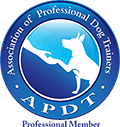Archived OLDT :: Harnessing the Power of Pavlov
Pavlov first described the phenomenon of associative learning. He discovered that, by pairing a stimulus that elicited no emotion with a stimulus that elicited an emotional response, he could imbue the neutral stimulus with that emotional response. For example, pairing a bell with food would cause the dogs to salivate in happy anticipation of food when just the bell was rung.
We ourselves are creatures of this type of learning in just about every aspect of our lives. Doesn't the Mr. Softy jingle bring a smile to your face whenever you hear it?! And with your dog, how about the happy jig he does whenever you pick up his leash? Again, a product of associative learning.
Pavlov has equipped us with a tool we can utilize in so many ways in training our dogs, more than you might realize.
Socialization
Socialization is a critical learning experience in your puppy's life. There's no such thing as over-socializing your dog. In fact, even after you pup has outgrown his sensitivity period, when the greatest learning takes place (ending somewhere between 13 and 16 weeks), continuing his socialization education is still important.
People come in all shapes and sizes and this is something your puppy needs to know. Human attire can also make people look very different: sunglasses, hats, facial hair, canes and wheelchairs, tool belts and uniforms. It's not enough to introduce your dog to many different people and ask them to give him a little pet and think this is socializing him. If he's afraid of the big, tall fireman with the uniform and the tool belt, then being handled by him will not be a pleasant experience. In human terms, this might be like being hugged by a grizzly!
However, you can change the experience for your pup by having the fireman offer him a tasty treat, an unconditioned stimulus in Pavlov's equation. If every bear you met was to offer you money, you might start to feel differently about them!
Training ABCs
When employing positive training, we use treats to reinforce, or reward, a target behavior. My clients often wonder how long they will have to keep giving treats; will they be tied to treats forever?! The answer is emphatically NO! Treats are an incentive for the dog to learn a challenging, new behavior. Once the behavior has been established, you reinforce intermittently, sometimes rewarding, sometimes not. Gradually, over time, the act of performing the behavior itself becomes reinforcing because of its happy history.
An example of this is training sit. To start, we use a treat as a lure for the dog to follow our hand as we pull the dog's head up (and consequently his butt down), resulting in a sit. In no time, the dog is effortlessly going into a sit when we cue it. We ask for sits frequently throughout the day, when we're putting the leash on before a walk, when we're putting down a stuffed Kong, before we offer a rope toy for a game of tug. Many wonderful life rewards are earned by a sit. The act of sitting itself becomes imbued with positive, happy feelings.
Expectant Parents
When I learn that clients of mine are expecting their first child in the months ahead, I immediately suggest preparing their dog for the change. They often respond by saying that their dog is quite alright around children, that he spent an evening in the company of another family with little ones and he was perfectly fine. Well, in short, I would hope so. We'd have a lot more to worry about if he hadn't been happy in their presence. Still, the landscape might be quite a different one when the family dog realizes that he's going to be sharing his space and his favorite people with a little tyke. It's this added twist that I like to prepare him for.
My preferred prescription for this is a special chewy, perhaps a pig's ear, something your dog thinks is pretty fabulous. Purchase a CD of baby noises. Start at a low volume and give your dog his chewy. Play it for a little while. Then turn the CD off and take the chewy away. (Of course you shouldn't use this technique if your dog guards chewies.) Allow for a bit of silence, then repeat: CD on, offer chewy. Little by little, you might notice a look of pleasant anticipation when your dog hears the CD. He has now built a happy association between baby sounds and something pleasurable. Over the weeks and months you do this work, gradually increase the volume.
So, you might ask: Will you have to give your pup a chewy every time the baby cries? No! We're imbuing baby sounds with positive feelings in our dogs. Once achieved, the sounds of the baby will make your dog feel inherently happy.
An additional note: Make sure that you are not attending to your dog when the CD is on and he is working away at the chewy. Remember that, when you're with your baby, you will likely not have the resources to also attend to your dog; hence you're preparing him to share you.
Treating Fear
Dealing with issues involving fear has an important added component called threshold. If your dog is above this threshold, he is experiencing the fear caused by the stimulus while, below the threshold, he is nonreactive and composed. You must determine, when designing your dog's treatment, where his threshold is and stay below it. Below threshold, your dog is capable of soaking in the new experiences. Above threshold, your dog is in a state of fear and not capable of experiencing the learning needed to discover that the scary thing is not really so scary. So what would a treatment like this look like?...
Riding in a Car
For instance, how would I treat a dog with a fear of riding in a car? Well, for starters, I'd try to discover something that he loves -- perhaps playing fetch with tennis balls, since it's hard to be fearful when playing. I might open all the car doors and play a game of fetch around the car. That would be enough for the first day. The next day I might start with that same game of fetch but perhaps throw a ball or two into the back seat. As the treatment progresses, I might sit in the back seat with the dog with one or more of the doors closed, playing ball. Then I might move to the front seat with the dog in the back, playing ball. Then maybe I'd turn the key in the ignition just enough to turn on the electronics of the car but not the motor and play some ball. Then I'd turn on the ignition and play ball and turn off the car. Then I'd turn on the ignition, move an inch, play ball, and turn off the car. You can see how this is going... very slowly and methodically. If, anywhere along the way, the dog shows signs of stress or fear (salivating, tucked tail, etc), then I've gone over-threshold and must step back to where he's comfortable again.
An additional note: Keep in mind that, though food can be used as the unconditional stimulus in place of playing fetch, too much food could actually cause carsickness when the car is finally moving, and this might intensify the dog's anxiety about riding in cars.
Sound Sensitivity
Many dogs are afraid of loud noises, such as the vacuum cleaner, fireworks, and thunderstorms. How can we get below threshold with these stimuli? Putting the dog in one room with a chewy and then having someone turn on the vacuum at the far end of the house would be one way to start to treat the former. Buying a CD that has fireworks or thunderstorm sounds and starting at a very low volume might work for the latter.
An additional note: Thunderstorms are tricky because, long before the start of the storm, the air pressure changes might evoke the fear. Also, should a storm sweep through town, there's no way to prevent the dog's experiencing it above threshold during treatment. Medications such as Xanax can be used to take the edge off during an actual storm.
Harnessing the Power
So, as you train and socialize your pup, as you get him used to his crate, to being handled, and to your handling his resources, and as you help him resolve his fears, associate these challenging life lessons with the things that he enjoys most in life -- food, toys and playtime, walks, petting and love.




